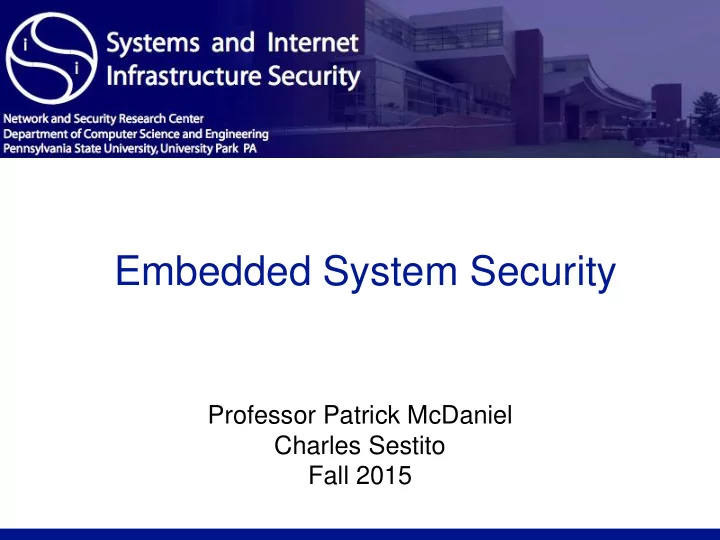

Embedded System Security Professor Patrick McDaniel Charles Sestito Fall 2015
Embedded System • Microprocessor used as a component in a device and is designed for a specific control function within a device ‣ Used In: • Cell Phones • Household appliances • Camera • And more Page
Requirements • Low cost • Fast • Fit within hardware and software constraints • Size (must be small) • Reliable • Reactive • Real-time Page
Attacks on systems • Many different types of attacks ‣ Embedded Software Attacks ‣ Physical Attacks ‣ Logical Attacks ‣ Timing Analysis ‣ Power Analysis ‣ Fault Induction ‣ Electromagnetic Analysis Page
Embedded Software Attack • Three factors that contribute to security risks in embedded software ‣ Complexity ‣ Extensibility ‣ Connectivity Page
Complexity • Software is complicated • The more complex the code, the more possibly bugs and vulnerabilities • Unsafe programming language ‣ C++ is very common Page
Extensibility • Modern systems are designed to be extended ‣ Updates ‣ Extensions • Loadable device driver and modules must be accounted for Page
Connectivity • Some embedded systems are being connected to the internet ‣ Even more so with IoT • Possible small failures could lead to security breaches • Attacker can use series of automated attacks Page
Physical Attack • Eavesdropping ‣ Probes listen in on inter-component communications • Micro-probing ‣ Use normal communication interface and abuse security vulnerabilities ‣ De-packaging Page
De-Packaging • Use fuming acid to dissolve resin covering silicon of a chip package • Recontruct the layout using a systematic combination of microscopy and invasive removal of covering layers ‣ Internals of the chip can be inferred ‣ Can obtain ALU, ROM cells, instruction decode, and more in detailed view with this technique • Microprobe to observe interfaces between components Page
Logical Attack • Send messages to device, observe response • Trick device into revealing the key • Exploits design flaws Page
Timing Analysis • Keys can be determined by analyzing small variations in the time required to perform cryptographic computations Page
Power Analysis • Operating current drawn by hardware is correlated to computations being performed • In most IC’s, logic gates and losses due to parasitic capacitance are major contributors to power consumption • Two types ‣ Single power analysis ‣ Differential Power analysis Page
Fault Induction • Security isn’t only software dependant ‣ Hardware failing to make proper computations is a security vulnerability • RSA implementation can be compromised if any computation errors Page
Electromagnetic Analysis • Documented since the 80’s • Measures electromagnetic radiation emitted by device to reveal sensitive information • Success deployment requires knowledge of chip layour • Two types ‣ Simpler EMA (SEMA) ‣ Differential EMA (DEMA) Page
Design challenged • Processing Gap • Battery Gap • Flexibility • Tamper Resistance • Assurance Gap • Cost Page
Processing Gap • Some systems are not capable of keeping up with computational demands of security processing ‣ Increase data rates and complexity of security protocols • Processing gap is obvious in systems which need to process high data rates ‣ Network routers, firewalls, web servers Page
Battery Gap • Battery capacity increases at an average of 5-8% per year • Security processing energy requirements outpace the increase in battery capacitance ‣ Leads to battery gap Page
Flexibility • Embedded systems often required to execute multiple and diverse security protocols • Need to be able to support ‣ Multiple security ‣ Interoperability in different environments ‣ Security processing in different layers of the network protocol stack Page
Tamper Resistance • Attacks due to malicious software ‣ Most common • Viruses • Trojan Horses ‣ Can exploit OS vulnerabilites ‣ Disrupt normal functioning Page
Assurance Gap • Truly reliable systems are much more difficult to build • Reliable systems must be able to handle wide range of situations • Secure systems should be able to operate despite attacks • Increase in complexity makes it more difficult to realize if something was overlooked Page
Cost • Fundamental factor that influences the security architecture • Increase in security leads to increase in cost • Designer’s responsibility to balance security cost Page
Security Levels • Level 1 ‣ Requires minimal physical protections • Level 2 ‣ Requires addition of tamper-evident mechanisms • Seal or enclosure • Level 3 ‣ Stronger detection and response mechanisms • Level 4 ‣ Mandates environmental failure protection and testing Page
Countermeausres Page
Software Security • Best approach is to think about security early on • Software security should be applied at various levels ‣ Requirements level ‣ Design level ‣ Code level Page
Physical Attacks • Hard to use because of chip size, smaller = better • Expensive compared to other attacks Page
Logic Attacks • Logical attack countermeasures ‣ Ensure privacy and integrity sensitive code and data ‣ Determine that it is safe from a security standpoint to execute a program ‣ Identify and remove software bugs and design flaws Page
Timing Analysis • Obvious countermeasures don’t work ‣ Quantizing total time ‣ Adding random delays • Message blinding can be used with RSA • Make all computations the exact same time • Other public=ley cryptosystems Page
Power Analysis • Run other circuits simultaneously ‣ Doesn’t prevent attack but attacker needs more samples • Effective countermeasures are mathematically rigorous and non-intuitive • Effective countermeasure remain expensive and challenging Page
Fault Induction • RSA implementations can check their answers by performing a public-key operation • Many cryptographic devices include an assortment of glitch sensors ‣ Detect condition likely to cause computation errors Page
Work Cited • Adapted from Dr. Mohammad Tehranipoor slides Page
Recommend
More recommend